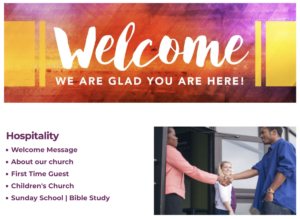An Unforgettable Day
I’ll never forget Sunday, March 15, 2020. On this day, Cascade United Methodist Church, where I serve as the technology director, suspended its in-person services and weekly activities indefinitely due to safety concerns regarding the COVID-19 pandemic. With the future of the ministry uncertain, the pastor met with the church’s leadership team and me to address some daunting yet valid questions. What impact will eliminating onsite worship have on outreach, community initiatives, and giving? Will staff begin to work from home instead of coming into the building? And most importantly, in what way will worship continue during the physical church closure? Cascade has a long history and reputation of offering spirited worship services and uplifting musical concerts, and closing the building doors would be heartbreaking.
Additionally, the church had no plan to operate solely as a virtual ministry for an indefinite timeline. In addition to Cascade, I provide technology support to many small, predominately Black churches in Atlanta. Several pastors of these congregations expressed concerns about successfully executing quality ministry efforts primarily in a virtual space while maintaining a rich cultural experience and connection to their surrounding communities. Quite a few of these ministries had minimal technology resources to live stream Sunday services and engage people online during the week. Also, several church leaders faced budget constraints, a lack of volunteers, and minimal knowledge on how to integrate digital tools into the life of the ministry to reach a broader audience and win more souls.
To help address the technology apprehensions and challenges that many small Black congregation leaders were encountering, I developed virtual church models using website and mobile app templates. These platforms provided ministries with streamlined methods to quickly establish an online presence and create a space for virtual worship and digital engagement upon transitioning away from in-person ecclesial gatherings.
What is the Virtual Church Model?
The virtual church model is an online portal that provides users with a similar engagement experience and connection as they would get in the physical ministry space. This experience includes viewing live Sunday services, participating in small group activities, and partaking in Christian education opportunities. In March 2020, I conducted a technology needs survey with over 100 pastors and leaders of small churches (350 members or less) at the onset of the Coronavirus pandemic. In response to a question about an excellent online presence, 56 percent of the respondents did not have a website, or the existing church site was outdated. The virtual church model can not only be used to serve as a church’s initial and primary site, but it can also be added to an existing one as an additional page for users to stay connected to the ministry.
To provide free virtual church models for the small ministries, I created templates using Google sites for the pastors who participated in the survey to test with their congregations. I also provided training materials and tutorial videos to ensure easy setup, customization, and implementation of the model’s user engagement opportunities, virtual reality spaces, and online giving options. There are also sections for hospitality Services and discipleship connections in the layout.
Many of the pastors who took the survey shared the virtual church model with their colleagues. As a result, over 500 additional ministry leaders explored the model, and 125 duplicated a copy to be customized and used for their churches. A follow-up survey conducted in April 2021 indicated that 70 percent of the ministries that implemented the model experienced growth in church membership, online giving, and Christian education participation.
In addition to the website template of the virtual church model, a mobile app version was created and piloted at two churches. Those ministries experienced a significant 35 percent increase in giving and member engagement during one year of implementation. It’s my goal to increase the number of churches that use the mobile app model as cell phones and tablet devices continue to grow as people’s primary way to access the internet.
What did I discover?
For ministries that used the virtual church model, it served as a springboard to quickly establish an online community during the COVID-19 health crisis, especially for congregations that didn’t have a website before the pandemic. Some pastors and church leaders have enhanced the model with professional graphic design elements and branding components. Others have incorporated the model layout in upgraded or newly created websites. The virtual church model brought awareness about the importance and value of technology to many ministries that didn’t consider digital tools necessary before congregations ceased in-person worship two years ago. Many small churches that were using cell phones to live stream worship services in March 2020 are investing in media equipment to present a quality broadcast to the world to engage and sustain an online audience.
What’s next for my project?
To expand the virtual church model, I plan to work with website developers and online experience experts to offer user accounts where people can create a profile to personalize their virtual church experience. From saving sermon notes to receiving custom Bible study plans, users will be able to have a custom model to best meet their needs. I also plan to merge the control panel for the website and the mobile app versions of the virtual church model so ministries using both models can manage content and layouts in one place.
I’ve relied heavily on church technology experts’ scholarship and the professional resources of Peter DeHaan,1 Douglas Estes,2 Kelly Bean,3 and Dwight Friesen4 to guide my research and work on the virtual church model. Their publications and lectures have helped to shape my thinking around the theological implications of church technology and the importance of data analysis to determine virtual ministry impact.
In conclusion, the virtual church model project has opened doors for ministries to present themselves to the online world. It also exposed pastors to technology’s boundless possibilities and power to reach new audiences. I hope that the model will continue to impact ministries globally and draw people to the church for years to come.
1 Peter DeHaan, Visiting Online Church: A Journey Exploring Effective Digital Christian Community (Grand Rapids, MI: Rock Rooster Books, 2021), 25.
2 Douglas Estes, Simchurch: Being the Church in the Virtual World (Grand Rapids, MI: Zondervan, 2009), 48.
3 Kelly Bean, How to Be a Christian Without Going to Church: The Unofficial Guide to Alternative Forms of Christian Community (Grand Rapids, MI: Baker Books, 2014), 83.
4 Dwight J. Friesen, Thy Kingdom Connected: What the Church Can Learn from Facebook, the Internet, and Other Networks (Grand Rapids, MI: Baker Books, 2009), 117.




